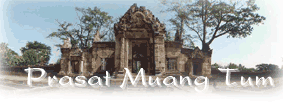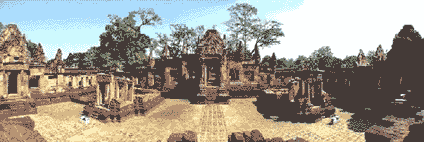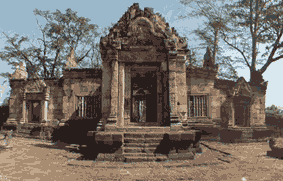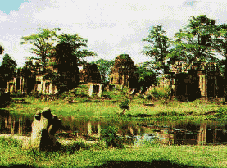
More Pictures in the area of Prasat Muang Tum
Prasat Muang Tum (The low land's castle) is located in the locality of Jorakei Mak, Prakonchai district, Burirum province.
Prasat Muang tum is a brickwork castle. Surrounding parapets and gates is sandstone. Outer walls are built with laterite stone. A castle mound is quadrilateral, surrounded by ponds. The prominence of Prasat Muang tum is that its parts are exquisitely carved. It is near several important ancient remains such as a grand pond dredged at the same time as the castle was constructed. The grand pond is approximately 510 meters wide, 1090 meters long. The pond's edges are line with laterite stone from the ground level to the bottom of the pond. The grand pond is always filled with water.
It is called Prasat Muang Tum (the low land castle) because it is located on a plain. Compared with Prasat Kao Panom Rung, which is located on the top of the mount, Prasat Muang Tum is a shrine, Bapuan Khmer arts, built around the year 1551-1630 or the 16th-17th century of the Buddhist era. Prasat's characteristics are consisted of;
1. Five brickwork castles; ; lined into 2 rows, 3 in the front row and 2 in the back row. Single based, squared plan, and smoothed brick surfaced.

The front row
-
A main pagoda; centered positioned but slightly forward. It is bigger than the rest four pagoda. Lintels are made from sandstone, carved as the image of Dheva(angel) lifts his knee on the base above the Sien Kiet Muk. The top part of the lintel is carved images of 7 ascetics saluting and sitting in row.
-
North pagoda; 4x4 meters size. Its gate is on the east. Sandstone lintels are carved images of Siva riding his royal cow (named Non Tee), holding lady Prapatee on left hand, holding a trident on the right hand. Non Tee stands on the base above the Sien Kiet Muk, returning a necklace of flowers. Top edge is carved images of 10 ascetics, embracing knee and saluting.
-
South pagoda; 4x4 meters size. Its gate is on the east. Sandstone lintels are carved images of Dheva(angel), sitting with his right knee up, above the Sien Kiet Muk, returning necklace of flowers on both sides. Top edge is carved image of 9 sitting ascetics.
The back row
-
North pagoda; 4x4 meters size. Its gate is on the east. Sandstone lintels are carved images of Krishna lifting the Mount Kovantana.
-
South Pagoda; 4x4 meters size. Its gate is on the east. Sandstone lintels are carved images of Pra Aruna sitting with his knee up in above the base, which is lifted by 3 swan above the Sien Kiet Muk, returning flowers on both sides.
2. A curvy balcony and gates; brickwork, 38.60x38.60 meters size. Gates on each side are built with sandstone. This curvy balcony is similar to general curvy balcony, with sandstone roof that is similar to the boat's roof. There are 3 gates with base lifted above the surrounding ground. The central gate, which is the main gate, has the size of 2.10x1.15 meters. There are 2 blank windows on each gate's side. The outsides are balustrades.
The outside of the eastern antechamber are carved images of Dheva(angel), sitting with his right knee up, above the Sien Kiet Muk. Above this image, there are five-headed Naka doubly cover on both side. Sandstone lintels are carved images of Kiet Muk returning necklace of flowers on both sides.
The central gate's columns are carved images of Singha, arm resting on his waist. Bases are carved images of sitting and saluting ascetic.
The inside of the east antechamber are carved images of Singha among apes and elephants, and decorated with flora. Lintels are carved image of Krishna defeating Naka Kaleeja.

3. Ponds ; located in the 10x10 space surrounding, outside, the 4 sides of the curvy balcony. These 4 ponds' size is 20x40 meters. The ponds' bottoms are lined with layered sandstone. Tapered shape from top to bottom. Raising neck Naka sculpture is placed at each edge of the ponds. At both side of a walkway, between the curvy balcony's gate and the wall's every gate, there are stairs to ponds. Above the stair, there were arch gates but, sadly, they no longer stand up.
4. Parapets and Gates ; outwardly located, 10 meters away from ponds. Parapets are built with laterite stone, squared and size 140x114.50 meters. Its top was grooved to place squared stone pipe. Four gable ends with 3 apertures. Sandstone roof is similar to boat's roof. A sandstone lintel above the eastern gate is a carved image of Krishna defeating Naka Kaleeja. The western gate shows the sign of unfinished decoration. Between the 3 gates are blank windows decorated with balustrades along side the laterite wall. There is a 1-meter wide walkway laid by laterite stone around the place.
Ta Lay Muang Tum(Muang Tum lake)
Ta Lay Muang Tum or Sra Barai at Koke Muang Village, Locality of Jorakei Mak, is the biggest pond. It was dredged as the same time as the castle was built. It is 200 meters north of Prasat Muang Tum. The pond was dredged for public consumption and irrigation. The pond is 510 meters wide, 1090 meters long and 3 meters deep. 3 layers of laterite stone are laid on the pond's edges. There are piers on the longer edges, north and south, 6.90 meters wide and 17 meters long. Floor, laid by laterite stone, is declined towards the pond. This pier was built as 5-steps stairs, oppositely located at the middle of the long edges.
There could be a way for collecting inflow water from the west of Mount Plai Nud and Mount Panom Rung, at the area called Khmer Bridge. Outflow was on the northeast and the southeast.

The prominence of Prasat Muang tum is that it has plenty of exquisite Arts and Architectures. Also, villages around the area of Prasat are worth visiting because the villagers' lifestyle has been related to the beauty of the Prasat. The long remarkable relation has become a graceful and peaceful environment.
Traveling to Prasat Muang Tum can be made in various way. Most people take the route that links Burirum-Nang rong-Panom Rung to Prasat Muang Tum, which is 83 kilometers from the junction. An alternate road is the route Burirum-Prakonchai to Prasat Muang Tum, which is 16 kilometers long from the main road. The other possible way is the route Prakonchai-Ban kruad, which is the parting road from the route Saitako-Panom Rung- Lahan sai. (Map)

Translator : Aketawan Manowongsa
11 September 2000
|
Translation Service Khanob Thai Co.,Ltd. Thai/English/ Japanese/Chinese www.khanobthai.com |